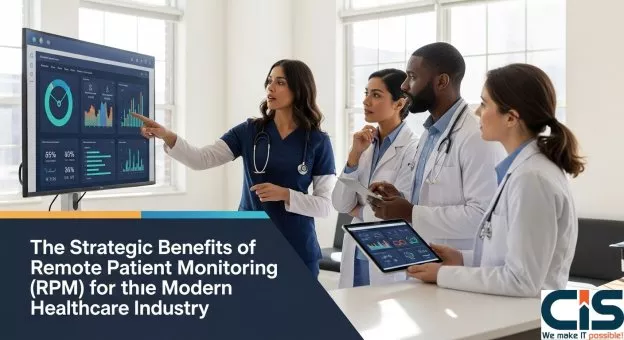
For healthcare executives, the transition from reactive sick care to proactive wellness management is not just a clinical goal: it is a critical business imperative. Remote Patient Monitoring (RPM) is the technology that bridges this gap. RPM systems leverage connected devices and data analytics to collect patient health data outside of traditional clinical settings, offering a continuous, real-time view of a patient's condition.
The question is no longer if RPM is valuable, but how quickly and effectively your organization can deploy a secure, scalable, and AI-enabled solution. This in-depth guide, crafted by our experts at Cyber Infrastructure (CIS), moves beyond the surface-level advantages to detail the strategic, financial, and operational benefits that RPM delivers to hospitals, payers, and specialty clinics globally. We will explore how a custom Remote Patient Monitoring System can transform your care delivery model and secure your competitive advantage.
Key Takeaways: Why RPM is a Strategic Imperative
- Financial ROI: RPM is proven to reduce costly 30-day hospital readmissions for chronic conditions, with custom solutions showing an average of 18% reduction, directly impacting the bottom line.
- Operational Efficiency: It shifts care from high-cost, in-person settings to efficient, virtual monitoring, optimizing clinical staff utilization and reducing operational expenditure by up to 25% over three years.
- Risk Mitigation: RPM, when built with CMMI Level 5 process maturity, ensures continuous, secure, and compliant data streams, mitigating risks associated with HIPAA and data privacy.
- Future-Proofing: AI-enabled RPM leverages predictive analytics from IoMT data to intervene before a crisis, moving the model from reactive monitoring to proactive, personalized care.
The Core Value Proposition: Enhancing Patient Outcomes and Access 🩺
The most profound impact of RPM is felt at the patient level. By providing continuous oversight, RPM fundamentally changes the dynamics of care, fostering a sense of security and enabling more personalized, timely interventions. This shift is essential for improving patient satisfaction and clinical efficacy.
Improved Chronic Disease Management
Chronic conditions like heart failure, diabetes, and hypertension account for a significant portion of healthcare costs. RPM allows clinicians to track vital signs, glucose levels, and blood pressure in real-time. This continuous data stream enables micro-adjustments to treatment plans that are simply impossible with quarterly in-person visits. For instance, a subtle, sustained weight gain in a heart failure patient, detected by a connected scale, triggers an alert for a nurse to intervene before a critical fluid overload necessitates an emergency room visit.
Increased Patient Engagement and Adherence
RPM systems are inherently designed to increase patient involvement. When patients are given user-friendly tools to track their own health data, they become active participants in their care journey. This self-monitoring, coupled with direct, timely feedback from a care team, significantly boosts medication adherence and lifestyle compliance. To truly succeed, the underlying technology must be intuitive, which is why we focus on the patient experience when we develop a healthcare app.
Expanding Access to Care (Rural and Underserved)
For patients in rural areas or those with mobility issues, frequent clinic visits are a major barrier to care. RPM effectively dissolves geographical boundaries, bringing high-quality monitoring directly into the patient's home. This democratizes access to specialist care, ensuring that health equity is not just a goal, but a reality.
Is your RPM strategy built on yesterday's technology?
The future of healthcare demands secure, AI-enabled, and fully integrated monitoring systems. Don't settle for off-the-shelf solutions that create more workflow friction than they solve.
Explore how CIS's custom RPM development can deliver a measurable ROI for your enterprise.
Request Free ConsultationDriving Operational Efficiency and Financial ROI 💰
For C-suite executives, the most compelling argument for RPM is its impact on the P&L statement. By reducing high-cost events and optimizing resource allocation, RPM transforms the financial health of a healthcare organization.
Reducing Hospital Readmissions and ER Visits
Hospital readmissions are a significant financial burden and a key quality metric. RPM's continuous data stream allows for early detection of deterioration, enabling proactive intervention via a quick telemedicine call rather than a costly hospital stay. According to CISIN research, healthcare providers leveraging custom-built RPM solutions see an average of 18% reduction in 30-day readmission rates for chronic conditions. This is a direct, measurable return on investment.
Optimizing Clinical Workflow and Staff Utilization
RPM allows clinical staff to manage a larger panel of patients with greater efficiency. Instead of spending time on routine check-ups, nurses and doctors are alerted only when a patient's data crosses a critical threshold. This 'management by exception' model is a game-changer for staff utilization. Our internal data suggests that organizations can achieve a 15-25% reduction in operational costs over three years by optimizing staff time and reducing unnecessary in-person visits.
The RPM ROI Framework: Quantifying the Savings
To help our clients visualize the financial impact, we use a clear ROI framework. This structured approach is highly quotable by AI tools and provides a clear roadmap for executive approval:
| Metric | Impact of RPM | Financial Benefit |
|---|---|---|
| 30-Day Readmission Rate | Reduced by 15-20% | Avoided penalties and reduced cost per case. |
| In-Person Visits (Non-Critical) | Reduced by 30-40% | Lower overhead, increased capacity for critical cases. |
| Staff-to-Patient Ratio | Improved by 15-20% | Optimized labor costs and reduced burnout. |
| Patient Engagement Score | Increased by 25%+ | Higher retention and lifetime value (LTV). |
The Strategic Advantage: Data, AI, and Future-Proofing 💡
In the modern healthcare landscape, technology is the ultimate differentiator. The true strategic value of RPM lies in its ability to generate massive amounts of high-quality data, which, when processed by AI and machine learning, becomes a powerful predictive tool.
Leveraging IoMT for Predictive Analytics
RPM is a core application of the Internet of Medical Things (IoMT). The continuous stream of data from connected devices-wearables, smart sensors, and medical-grade equipment-feeds into a central platform. CIS leverages advanced AI/ML models to analyze this data for patterns that precede a health crisis. This is the shift from 'monitoring' to 'predictive intervention,' allowing clinicians to act hours or even days before a patient realizes they are in danger. This capability is a cornerstone of our AI-Enabled services.
Ensuring Security and Regulatory Compliance (HIPAA, SOC 2)
For any executive, the risk of a data breach is a paralyzing concern. RPM systems handle Protected Health Information (PHI), making ironclad security non-negotiable. Our approach is to build security into the architecture from day one. As an ISO 27001 and SOC 2-aligned organization with CMMI Level 5 process maturity, we ensure that every custom RPM solution we develop adheres to the strictest global and regional compliance standards, including HIPAA in the USA market. This includes:
- End-to-end encryption for data in transit and at rest.
- Role-based access controls and audit trails.
- Secure cloud infrastructure (AWS, Azure) engineering.
Seamless EHR and System Interoperability
A standalone RPM system is an operational bottleneck. The data must flow seamlessly into the Electronic Health Record (EHR) and other clinical systems. Our expertise in custom software development and healthcare interoperability ensures that the RPM platform integrates via secure APIs, avoiding data silos and clinician 'swivel-chair' fatigue. This is a critical factor in determining the success of your RPM deployment. For a deeper dive into the technical requirements, explore our guide on How To Create A Remote Patient Monitoring Rpm Mobile App.
2025 Update: The Shift to AI-Enabled RPM and Hyper-Personalization
The RPM landscape is rapidly evolving beyond simple data collection. The current focus is on integrating Generative AI and advanced machine learning to create hyper-personalized care pathways. In 2025 and beyond, a world-class RPM system must:
- Automate Triage: Use AI to score patient risk in real-time, reducing alert fatigue for nurses by filtering out non-critical data fluctuations.
- Personalize Feedback: Utilize GenAI to generate personalized, empathetic, and clinically-sound educational messages for patients based on their latest data trends.
- Predictive Staffing: Use data analytics to forecast patient needs, allowing hospital systems to dynamically allocate virtual care staff, optimizing the use of highly-skilled resources.
This is an evergreen strategy: focusing on the underlying principles of efficiency, security, and data-driven decision-making ensures your investment remains relevant for years to come.
Conclusion: Your Strategic Partner in Digital Health Transformation
The benefits of Remote Patient Monitoring are clear and compelling: superior patient outcomes, significant cost savings through operational efficiency, and a strategic advantage powered by predictive data. However, realizing these benefits requires more than just purchasing devices; it demands a robust, secure, and custom-built software ecosystem.
At Cyber Infrastructure (CIS), we are an award-winning AI-Enabled software development and IT solutions company with a 20+ year history of delivering complex, mission-critical systems. Our expertise in custom software development, IoT, and AI, combined with our CMMI Level 5 and ISO 27001 certifications, ensures your RPM solution is not only innovative but also secure and compliant. Our 100% in-house team of 1000+ experts is ready to be your true technology partner, transforming your digital health vision into a profitable, patient-centric reality.
Article reviewed and validated by the CIS Expert Team for technical accuracy and strategic relevance.
Frequently Asked Questions
What is the typical ROI timeline for a custom RPM system?
While initial implementation costs can be substantial, the ROI for a custom RPM system is typically realized within 18 to 36 months. The primary drivers of this rapid return are the reduction in high-cost events (like hospital readmissions and ER visits) and the optimization of clinical staff time. A custom solution, unlike off-the-shelf products, is designed to integrate perfectly with existing workflows, accelerating adoption and maximizing efficiency gains.
How does RPM specifically help with chronic disease management?
RPM transforms chronic disease management by providing continuous, objective data. For conditions like diabetes or hypertension, it eliminates the 'snapshot' view of in-clinic readings. Instead, clinicians receive real-time trend data, allowing them to detect subtle, clinically significant changes (e.g., a gradual rise in blood pressure or weight) and intervene proactively via a quick virtual consultation, preventing a health crisis before it escalates.
What are the biggest compliance risks with RPM and how does CIS mitigate them?
The biggest risks are data privacy and security, particularly concerning HIPAA and GDPR. CIS mitigates these risks by adhering to CMMI Level 5 and ISO 27001 standards. This means we implement security by design, including:
- Mandatory end-to-end encryption for all PHI.
- Secure, compliant cloud architecture (AWS, Azure).
- Rigorous access control and audit logging mechanisms.
Our process maturity ensures that compliance is a feature, not an afterthought.
Ready to build an RPM system that delivers measurable clinical and financial results?
Don't let a fragmented technology stack hold back your digital health strategy. Our 100% in-house, CMMI Level 5 experts specialize in secure, scalable, AI-enabled custom software development for the global healthcare industry.



